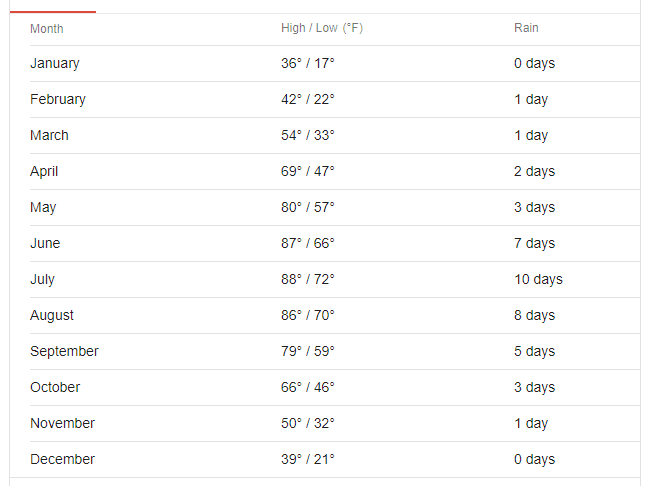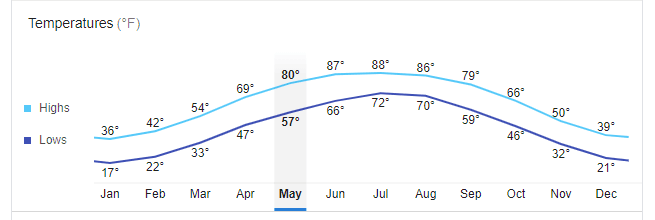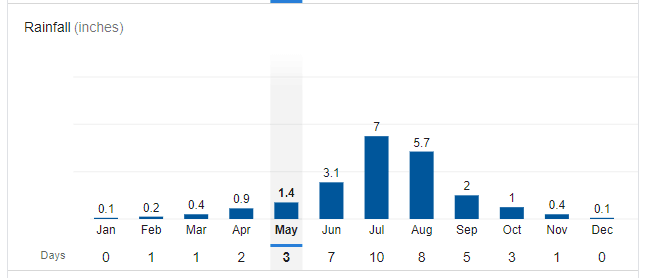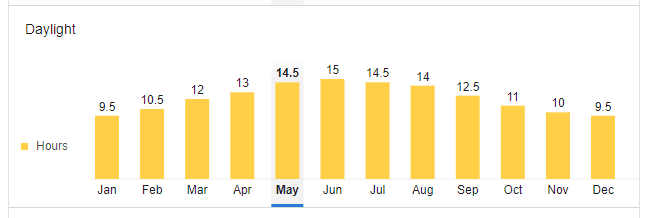
Beijing Climate
Beijing climate and weather is characterized by four distinct seasons, short and windy in spring, long and hot in summer, cool and pleasant in autumn, and chilly and long in winter. July and August are the hottest months, with highs around 37℃, while January is the coldest, with lows around -15℃.
Beijing Weather Graphs and Climate Features
Beijing lies in the warm temperate sub-humid region, belonging to the warm temperate sub-humid continental monsoon climate. Featuring four distinct seasons, Beijing is windy and dusty in spring, hot and rainy in summer, sunny and dry in autumn, cold and windy in winter. Spring and fall are very short, about a month or so, while summer and winter are long, nearly five months each.

Temperature

The annual average temperature in Beijing is 12.9°C. The average temperature in the coldest month(January) is -3.1°C, and in the most thermidor (July), the average temperature of 26.7°C. Extreme minimum temperature is -33.2°C (occurred on January 30, 1980), extreme maximum temperature of 43.5°C (occurred on June 10, 1961 in Fangshan district). In the urban area, extreme minimum temperature is -27.4°C (February 22, 1966), and the extreme maximum temperature of 41.9°C (July 24, 1999). Frost-free period is 180-200 days throughout the year, which is shorter in the western mountain area.
Precipitation

Beijing has obvious monsoon characteristics, and the distribution of precipitation season is very uneven. 60% of the annual precipitation is concentrated in July and August in summer, which is one of the rainiest regions in north China, while the air in other seasons is relatively dry. The average annual precipitation in the plain area is about 600 mm, the maximum annual precipitation in the urban area is 1404.6 mm, and the maximum 24-hour precipitation is 404.2 mm. The average annual maximum snow depth is 7.5 cm, and the historical maximum snow depth is 33.5 cm.
Sunshine Hours

The average annual sunshine hours in Beijing are between 2000 and 2800 hours. The maximum value is more than 2800 hours in Yanqing district and Gubeikou, and the minimum value is distributed in Xiayunling with about 2063 sunshine hours. During the rainy season in summer, the sunshine hours decrease and the monthly sunshine hours are around 230 hours. Although sunshine hours in autumn is not as much as that in spring, it is more than that in summer, with 230-245 hours of monthly sunshine. Winter is the season with the least sunshine in a year. The monthly sunshine hours is less than 200 hours, which is generally 170-190 hours.
Note: The graphs are for reference only.
Beijing Weather and Climate by Month
Four Seasons of Beijing & What to Pack
For four distinct seasons in Beijing, the scenery is beautiful and diversified in different time of a year. The climate is warm and windy from April to May in spring, burning hot from June to August in summer, pleasant and cool from September to October in autumn, and severe cold from November to mid-march in winter. The hottest month is July and the coldest month is January.
Spring(April-May)
- Weather Feature: warm but windy, and large temperature difference between daylight and night
- Average Temperature: 14-20°C
- What to Bring: You need some light clothing: a long-sleeved shirt or T-shirt, plus one or two jackets and sweaters. Wear warmly when going out at night. Also outdoors windbreaker is needed to protect yourself from sandstorms.
- Recommended Tour Activities: Hiking on the Great Wall and boating on Kunming lake are both good choices. Beihai park is also a good place for tourists to take a boat tour and appreciate the old buildings. You can also visit the Beijing botanical garden, where there is the largest rose garden in China.
Summer(June-August)
- Weather Feature: hot and rainy, when the temperature can reach 40°C.
- Average Temperature: 24-28°C
- What to Bring: Due to the temperature in July and August can reach 30-40°C, so you need to wear thin clothes like short-sleeved shirt and shorts. Keep an eye on the weather forecast and remember to bring a raincoat or umbrella just in case.
- Recommended Tour Activities: In summer, you can visit some cool places, such as the Summer Palace and Chengde mountain resort, which were the resort of royal family in the Qing dynasty (1644-1911), where you can enjoy exquisite landscape design and gorgeous architecture. In addition, the lotus flowers at Chengde mountain resort bloom from July to September and are very beautiful.
Autumn(September-October)
- Weather Feature: cool and pleasant(mild temperature and abundant sunshine), the leaves are changing colors.
- Average Temperature: 13-20°C
- What to Bring: Long-sleeved shirts and thin coats are suitable for autumn wear. Since from the late October, the temperature has dropped sharply, so you must wear warm clothes.
- Recommended Tour Activities: The short and beautiful fall from mid-September to the end of October is a favorite of travelers. The most attractive attractions in fall include the Badaling Great Wall, Xiangshan park and the Wuling mountain(frog mountain) on the outskirts of Beijing. Don't miss Xiangshan park(Fragrant Hills Park), where the red maple leaves are like fire. The best time to appreciate the maple leaves is from mid-October to November.
Winter(November-March)
- Weather Feature: severe cold and long; average temperatures in December, January and February are likely to fall below 0°C.
- Average Temperature: -4-5°C
- What to Bring: Be sure to wear a wool sweater and down jacket in winter.
- Recommended Tour Activities: Winter sports enthusiasts can enjoy the snowy scenery in Western Hill, skate in Shichahai, or visit some skiing resorts in Beijing. Badaling ski resort, Yuyang international ski resort, Jundushan ski resort are recommended. For those who are not interested in skating or skiing, watching the snow in the west mountain and the Forbidden City is very enjoyable. In addition, Chinese New Year is celebrated in January or February. Traditional community activities are a great experience for visitors from abroad. If you are in Beijing during spring festival, don't miss the temple fairs there.
Best Time to Visit
Beijing is good for traveling all year round. Given the frequent sandstorms in spring and extreme temperatures in summer and winter, the best times to visit Beijing is September and October. The autumn of Beijing exudes a sense of profound history, the fragrant hill in northwest is already the sea of flaming red, red maple leaves like the skirt of history adorn this ancient capital of thousands years. The early summer weather in May and June is also a good choice. At this time, the temperature in Beijing is comfortable and the rain is less, suitable for traveling. If you come to Beijing in winter, don't miss the snowscape.
High Season
The peak season begins in April and ends in October. During this time, the mild temperature and climate is perfect for traveling. As a result, the city is crowded with tourists and some popular scenic spots are inevitably crowded. Travel costs will also be higher, as many attractions have peak season prices.
Low Season
The off-season in Beijing is from November to March of the next year. The weather is getting colder and colder, and there are fewer tourists. Therefore, the ticket prices of air tickets, hotels and scenic spots are lower. However, you can enjoy the city's snowscape and have a good time because it will be less crowded in most tourist attractions.
Avoid Public Holidays in China
Try to avoid the public holidays of China, such as May Day Holiday(May 1-3), National Day Holiday(October 1-7), Spring Festival Holiday(Usually early February), Qingming Festival(in early April), Dragon Boat Festival(in June). Spring festival and national day festival are the most crowded time to travel. During these holidays, there will be a large crowd in the tourist attractions and you can't really enjoy yourself. Flights and hotels can cost three times as much than usual, and it's hard to get tickets during the Spring Festival. See Chinese National Holidays.












